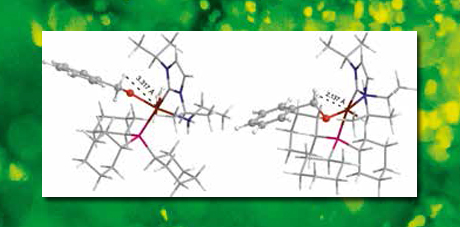
'Green' Synthesis of Amides
This project is focused at improving our understanding of the ruthenium-catalyzed process through a combination of experimental and theoretical work.
Amides are nitrogen-containing compounds which are important in biology and in organic chemistry. The amide bond is found in peptides, artificial polymers, drugs, and biologically active compounds. For example, 9 out of 53 small molecule drugs, whose sales exceeded 1 billion USD annually in 2003, contain an amide. This thesis contributes to the understanding of a novel, and environmentally benign pathway for the synthesis of amides.
Given the vast importance of amides, it is not surprising that a range of alternative methods for amide synthesis have been developed. Most however, have the same problem: they require additional reagents which do not end up in the products. In chemical terminology, they are not atom-economical.
In 2008, Madsen and co-workers published their discovery of ruthenium-catalyzed dehydrogenative coupling of primary alcohols to form amides. This direct pathway is highly atom-economical and is also considered “green” since only a small amount of catalyst is needed to make the reaction work efficiently.
This project is focused at improving our understanding of the ruthenium-catalyzed process through a combination of experimental work and theoretical techniques. In the experimental part, deuterium-labeled alcohols and amines were used. This revealed that ruthenium-dihydride species are involved in the catalytic cycle.
These experimental results were compared to a Density Functional Theory (DFT) / M06 computational study and a plausible catalytic cycle was proposed.
Further, this catalytic cycle was turned into a model which again would form the starting point for additional computer calculations. The aim of these calculations was to find even more effective carbene ligands. The study showed that ruthenium complexes with dimethoxyimidazolylidene and pyridilidene ligands could be more active than the RuCl2(IiPr)(p-cymene) complex used in the original study by Madsen and co-workers.
Further experiments with a mixture containing a N-ethyl pyridilidene-substituted ruthenium complex afforded the amide in 38 % yield. This indicates that computer (in silica) ligand screening might be used for catalyst optimization.
An improved protocol was developed for the ruthenium catalyzed dehydrogenative self-coupling of primary alcohols to give esters. Addition of 16.7 mol% of Mg3N2 to the reaction mixture gave esters from aliphatic alcohols in similar yields but at lower temperature as compared with a previously reported catalytic system. The additive also suppressed the decarbonylation of aromatic alcohols. A previously unknown ruthenium catalyzed dehydrogenative Guerbet reaction with secondary alcohols to give ketones was discovered.
It was found that only acyclic 2-methyl carbinols and simple cyclic alcohols underwent this transformation. It was shown that the reaction proceeded via an oxidation- aldol condensation-reduction pathway and that the active ruthenium species was a dihydride.